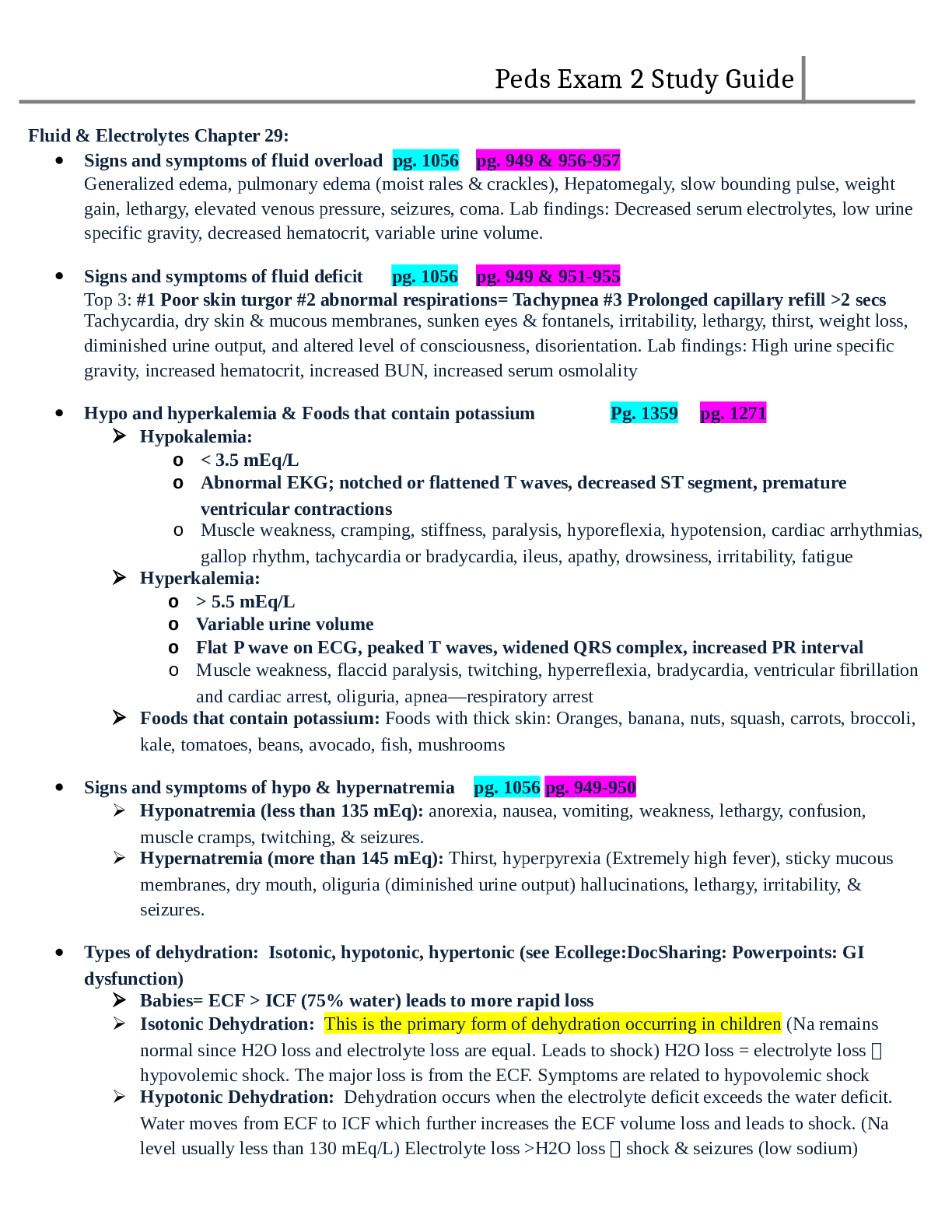Fluid & Electrolytes Chapter 29:
Signs and symptoms of fluid overload pg. 1056 pg. 949 & 956-957
Generalized edema, pulmonary edema (moist rales & crackles), Hepatomegaly, slow bounding pulse, weight
gain, lethargy, elevated venous pressure, seizures, coma. Lab findings: Decreased serum electrolytes, low urine
specific gravity, decreased hematocrit, variable urine volume.
Signs and symptoms of fluid deficit
pg. 1056 pg. 949 & 951-955
Top 3: #1 Poor skin turgor #2 abnormal respirations= Tachypnea #3 Prolonged capillary refill >2 secs
Tachycardia, dry skin & mucous membranes, sunken eyes & fontanels, irritability, lethargy, thirst, weight loss,
diminished urine output, and altered level of consciousness, disorientation. Lab findings: High urine specific
gravity, increased hematocrit, increased BUN, increased serum osmolality
Hypo and hyperkalemia & Foods that contain potassium
Hypokalemia:
Pg. 1359 pg. 1271
ooo< 3.5 mEq/L
Abnormal EKG; notched or flattened T waves, decreased ST segment, premature
ventricular contractions
Muscle weakness, cramping, stiffness, paralysis, hyporeflexia, hypotension, cardiac arrhythmias,
gallop rhythm, tachycardia or bradycardia, ileus, apathy, drowsiness, irritability, fatigue
Hyperkalemia:
o > 5.5 mEq/L
o Variable urine volume
o Flat P wave on ECG, peaked T waves, widened QRS complex, increased PR interval
o Muscle weakness, flaccid paralysis, twitching, hyperreflexia, bradycardia, ventricular fibrillation
and cardiac arrest, oliguria, apnea—respiratory arrest
Foods that contain potassium: Foods with thick skin: Oranges, banana, nuts, squash, carrots, broccoli,
kale, tomatoes, beans, avocado, fish, mushrooms
Signs and symptoms of hypo & hypernatremia pg. 1056 pg. 949-950
Hyponatremia (less than 135 mEq): anorexia, nausea, vomiting, weakness, lethargy, confusion,
muscle cramps, twitching, & seizures.
Hypernatremia (more than 145 mEq): Thirst, hyperpyrexia (Extremely high fever), sticky mucous
membranes, dry mouth, oliguria (diminished urine output) hallucinations, lethargy, irritability, &
seizures.
Types of dehydration: Isotonic, hypotonic, hypertonic (see Ecollege:DocSharing: Powerpoints: GI
dysfunction)
Babies= ECF > ICF (75% water) leads to more rapid loss
Isotonic Dehydration: This is the primary form of dehydration occurring in children (Na remains
normal since H2O loss and electrolyte loss are equal. Leads to shock) H2O loss = electrolyte loss
hypovolemic shock. The major loss is from the ECF. Symptoms are related to hypovolemic shock
Hypotonic Dehydration: Dehydration occurs when the electrolyte deficit exceeds the water deficit.
Water moves from ECF to ICF which further increases the ECF volume loss and leads to shock. (Na
level usually less than 130 mEq/L) Electrolyte loss >H2O loss shock & seizures (low sodium)
Read More
.png)

